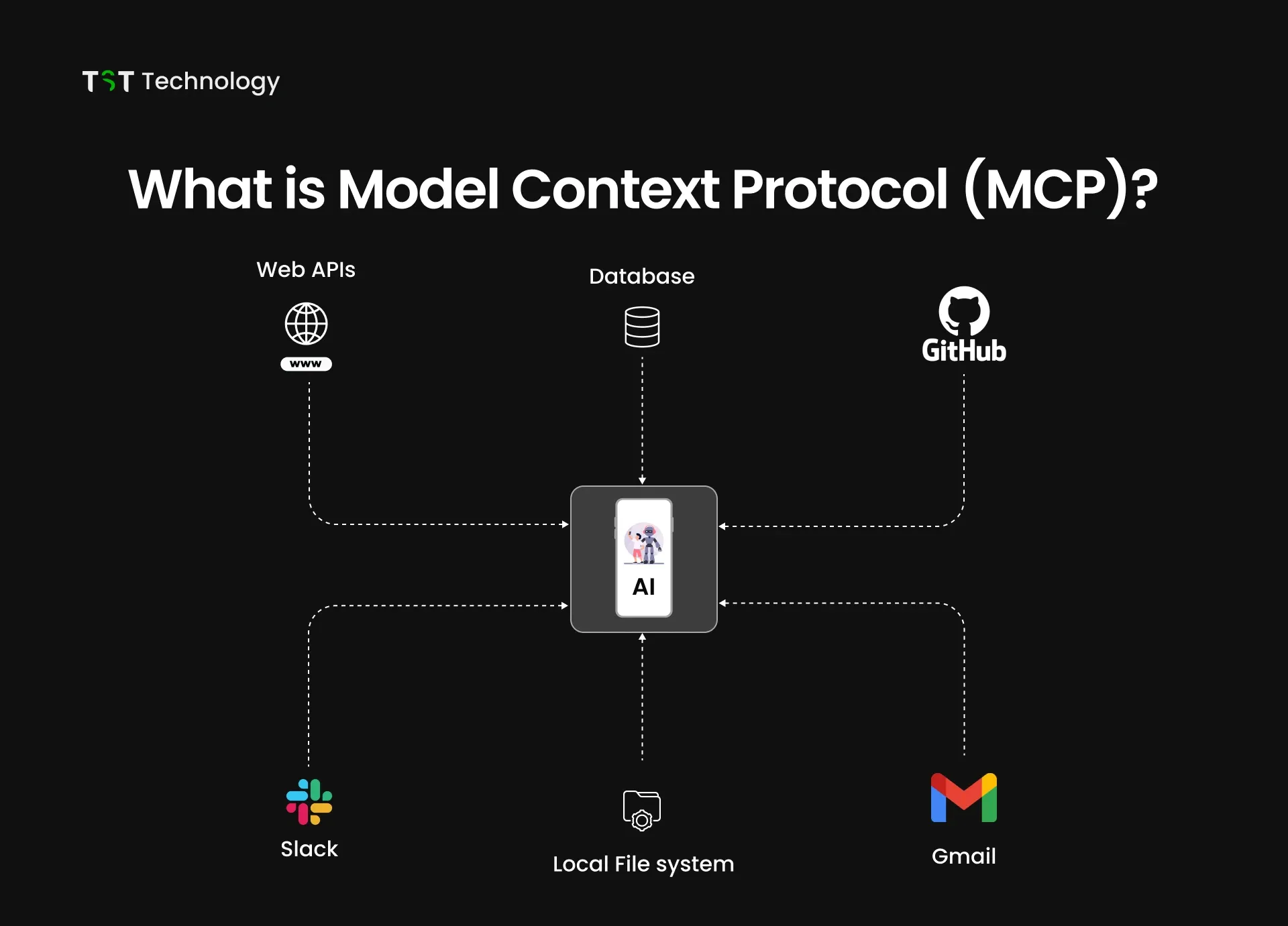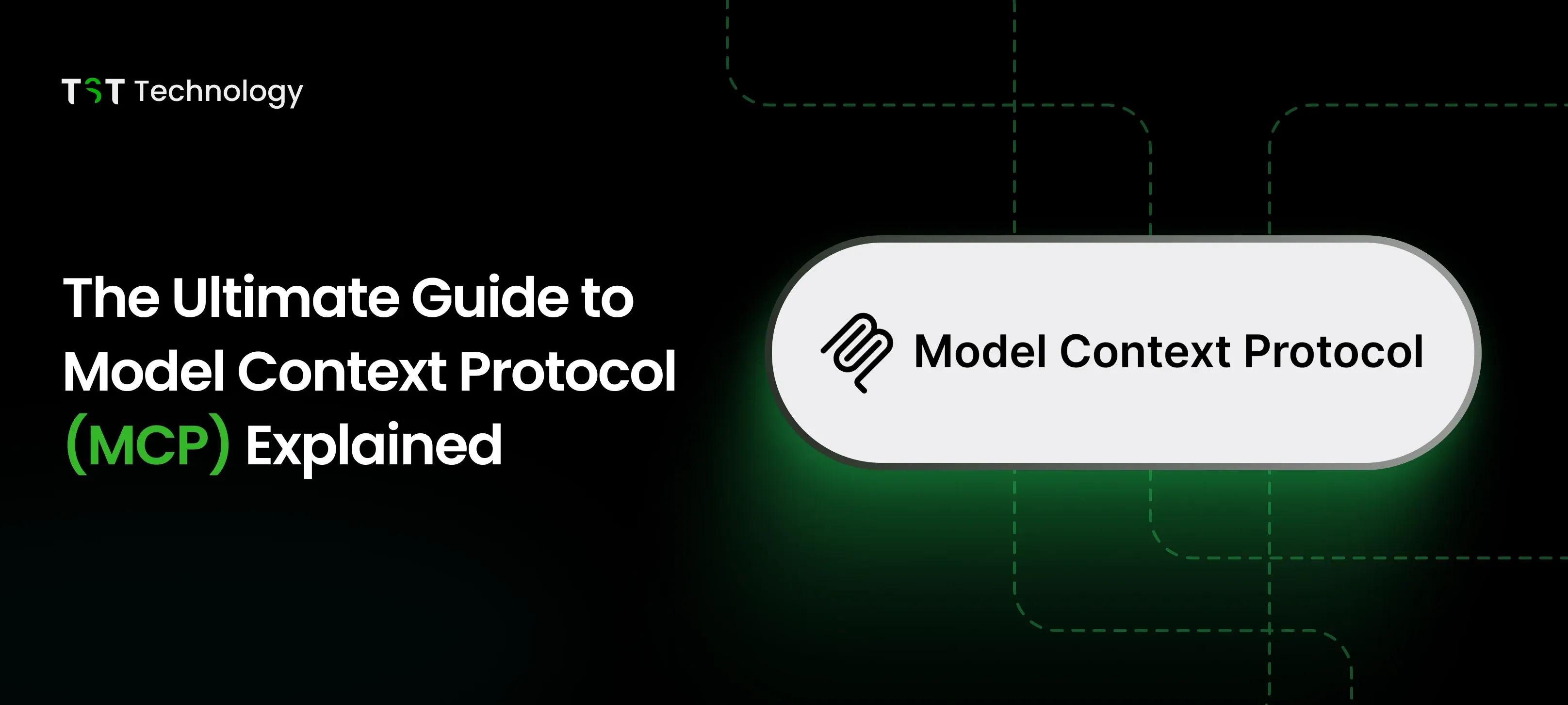What if your AI assistant could do more than just answer questions, like talk to your apps or fetch real-time data?
AI is not just about giving smart replies. It’s about working together with tools, apps, and systems to do useful tasks. That’s where Model Context Protocol (MCP) helps by acting like a smart link between AI and other systems.
You can even explore the open-source MCP SDK on GitHub to see how it connects AI with real-world applications.
In this blog post, we’ll explain what MCP is, how it works, why it matters, and how you can start using it.
What is Model Context Protocol (MCP)?

The Model Context Protocol (MCP) is an open system by Anthropic. It helps AI models, such as chatbots or language tools, connect with other tools, databases, or apps smoothly and organizedly.
MCP can be thought of as a bridge that lets AI talk to other systems and use their data or features easily.
Why Do We Need MCP Today?

As AI becomes smarter, it needs real-time data and access to tools to give better and more helpful answers. Old methods of connecting AI with other systems are messy and need custom work every time.
MCP fixes this by offering one simple and standard way to connect everything, saving time and making things work better together.
1. Fragmented Integrations (Before MCP)
- Before MCP, developers had to write custom code for every AI model and tool they wanted to connect. This took a lot of time, caused more bugs, and slowed down the work.
2. Faster Time to Market
- With MCP, you only need to set up the connection once. After that, it can work with many supported tools, saving time and letting you focus on building your main product.
3. Consistent Security
- MCP uses a smart security system where a host checks all actions. The AI asks for permission, and the host decides what is allowed, making everything safer and more controlled.
4. Improved AI Quality
- MCP gives AI direct and organized access to tools and data. This helps the AI give better answers, since it doesn’t have to guess; it can just use the right function or tool.
MCP brings speed, safety, and smarter results. It makes it easier for AI and tools to work together without extra effort.
Want to build smart integrations using MCP? Book a free 30-minute consultation and discover how we can help you implement advanced AI systems for your business.
How Does MCP Work?

MCP follows a client-server model where the client (like an AI assistant) sends commands, and the server handles tasks like fetching data or triggering actions in real-time.
MCP Servers
- These are small programs that offer certain features or services. They follow the MCP rules so AI tools can use them easily.
MCP Clients
- These are apps or tools that connect to MCP servers. They help AI models reach the right server to do a task or get data.
The Process
1. Host (MCP Client)
This is your AI app, like a chatbot or code assistant. It includes an MCP client library that helps the AI talk to the server.
2. MCP Server
This is a small program that offers services or features. It shares them using simple commands like get resources or run tools.
3. Communication Method
They talk to each other in two ways:
- Locally using input/output (for desktop apps), or
- Online using HTTP and events (for cloud-based or remote apps).
4. Example of a Request
When the AI needs something, like a file, it sends a request like this:
{ "id": 1, "method": "resources/get", "params": { "resource_id": "file_123" } }
The MCP server gets this request, finds the file, and sends it back. The AI then uses this information to give a better answer.
Model Context Protocol (MCP) Server Details
MCP servers can be created using different tools and programming kits (called SDKs). One common example is the Java SDK, which gives you everything you need to build an MCP server.
This Java SDK includes:
- Basic features and commands to make the server work.
Support for two ways to send and receive messages:
- STDIO (standard input/output) for local use.
- SSE (Server-Sent Events) is used to send updates over the internet.
If you're building a more advanced app, like one using Spring WebFlux (a Java tool for reactive apps), you can also add special extras to help it work better.
Core Parts of an MCP System
An MCP system has three main parts that help the AI do its job better:
1. Tools
- These are actions or functions the AI can use. For example, the AI might call a tool to search data or calculate something.
2. Resources
- These are like files or data that the AI can read. It can be things like a saved file, an API response, or any useful content.
3. Prompts
- These are ready-made message templates. They guide the AI or the user to complete a task more easily and clearly.
Important Features of the MCP Protocol

1. Standardization
- MCP gives a common way for AI models to connect with different systems, making it easier for them to work together.
2. Flexibility
- It can work with different tools and programming languages. So, no matter which software you use, MCP can connect to it.
3. Security
- MCP makes sure only authorized people or systems can access certain features, keeping everything secure.
4. Scalability
- MCP can handle many requests at once, so it works well even for big systems with lots of users.
5. Open and Verifiable
- MCP is open-source and available on GitHub, which means anyone can look at the code or contribute to it.
6. Versioned
- Every time there’s a change or update to MCP, it gets a new date tag so you can track the changes easily.
7. Streaming Support
- MCP can send data in pieces, so it’s faster and helps apps show updates in real-time.
8. Host-Mediated Security
- The host (server) checks each request and decides if it should be allowed based on set rules or the user’s permission.
9. Model-Agnostic
- MCP works with any type of AI model, whether it’s open-source or closed-source, making it very flexible.
How does MCP handle security and Updates?
Security is very important in MCP. The protocol makes sure that only the right people or systems can access certain information, keeping everything safe.
For example, MCP protects against attacks that could trick the system into bypassing its safety rules. This helps prevent unauthorised access.
To keep things secure, MCP also gets regular updates. These updates fix any new issues that might come up and improve the system's security.
Real-world Model Context Protocol examples
Many companies are using MCP to make their AI smarter and more helpful. Here are some examples:
1. Claude Desktop
- Claude Desktop uses MCP so AI models can work with local files and applications directly on your computer. This makes it easier for AI to handle tasks on your device.
2. GitHub Integration
- MCP helps AI models connect to GitHub. This way, AI can get details about code changes and pull requests, making tasks like code reviews faster and easier.
3. DataWorks
- DataWorks has an MCP server that lets AI interact with its cloud services. This helps AI manage cloud resources and perform operations more efficiently.
Benefits of Model Context Protocol (MCP)

MCP brings many benefits that help improve AI systems. Let’s look at how it makes AI more efficient, secure, and flexible.
1. Improved AI Performance
- MCP helps AI get real-time data, so it can give more accurate and useful answers.
2. Reduced Development Overhead
- Since MCP provides a standard way to connect with other systems, developers don’t need to create custom solutions every time, saving time and effort.
3. Enhanced Security
- MCP has built-in security features to keep data safe and make sure that only authorized users or systems can access it.
4. Scalability
- MCP can handle many users and tasks at the same time, making it perfect for large systems or services.
5. Flexibility
- MCP works with many different programming languages and tools, making it easy to use in different systems.
With its ability to improve AI performance and simplify development, MCP is a powerful tool for building smarter, more reliable systems. It's a great choice for anyone looking to enhance their AI capabilities.
Getting Started with the MCP Step-by-Step

I. Pick Your Server
- Local: For desktop apps, use simple input/output tools.
- Remote: For cloud apps, use HTTP/SSE for communication.
II. Install the SDK
- Python: Run the command pip install mcp-sdk
- JavaScript: Run the command npm install @modelcontextprotocol/sdk
III. Write Your Manifest
Create a file that describes the resources and tools. Example:
{
"resources": [
{ "id": "wiki", "type": "text", "url": "https://..." }
],
"tools": [
{ "id": "createIssue", "params": { "title": "string", "body": "string" } }
]
IV. Launch Your Server
Use the reference setup or build it on your chosen framework to run the server.
V. Connect from Your App
In your app, connect the client to the server:
import { MCPClient } from "@modelcontextprotocol/sdk";
const client = new MCPClient();
await client.connect("http://localhost:4000");
const tools = await client.listTools();VI. Test and Secure
- Run tests to make sure everything works.
- Set up security measures like OAuth or API keys for safety.
- Check logs to ensure proper functioning.
MCP is changing how AI models connect to external systems. Using a simple and safe way to link AI with tools and data makes the process more flexible and efficient.
Development Tools That Make Working with Model Context Protocol Easier
Software Development Kits (SDKs)
Official SDKs
The Model Context Protocol provides several officially supported SDKs that streamline development across different programming languages:
- Python SDK: The most popular choice, offering compatibility with machine learning tools like TensorFlow and PyTorch. It includes utilities for serializing model inputs/outputs, managing API authentication, and monitoring model performance metrics.
- JavaScript/TypeScript SDK: Designed for web developers, this SDK enables browser and Node.js compatibility for applications like dashboards or interactive tools. It emphasizes real-time interactions and provides both client and server capabilities.
- Java SDK: Focuses on enterprise-grade integrations with thread-safe clients and support for asynchronous operations, making it ideal for high-throughput systems. It supports STDIO, SSE, and Streamable-HTTP transport implementations.
Community-Supported SDKs
The MCP ecosystem includes community-maintained SDKs for additional languages:
- Go: Lightweight and performant options for microservices or CLI tools
- Rust: MCP CLI server templates and Poem web framework integration
- C#/.NET: Native AOT compatibility for high-performance applications
- Swift: Official SDK for Apple ecosystem development
- Ruby: Both official and Rails-specific implementations
High-Level Frameworks
FastMCP
FastMCP stands out as the most popular high-level framework, available in both Python and TypeScript versions:
- Python FastMCP: Provides decorator-based tool definition, automatic schema generation from function signatures, and support for multiple transport protocols (STDIO, HTTP, SSE)
- TypeScript FastMCP: Built on the official SDK but eliminates boilerplate code, includes session management, authentication support, and streaming capabilities
Other Notable Frameworks
Several specialized frameworks cater to different needs:
- LiteMCP: A lightweight JavaScript/TypeScript framework for quick server development
- mcp-framework: Fast and elegant TypeScript framework with enhanced developer experience
- ModelFetch: Runtime-agnostic SDK for deploying MCP servers anywhere TypeScript/JavaScript runs
- easymcp: Python framework with native asyncio support and caching capabilities
Development Environment Tools
MCP Inspector
The MCP Inspector is the primary debugging tool for MCP development:
- Interactive debugging interface for testing tools, resources, and prompts
- Real-time JSON-RPC message examination
- Direct server testing capabilities
- Can be run via npx @modelcontextprotocol/inspector <path-to-your-server>
IDE Integration
Modern development environments are adding native MCP support:
- VS Code: Built-in MCP server configuration through mcp.json files, support for Dev Containers, and profile-based server management
- Chrome DevTools: MCP server for debugging web applications directly within AI coding assistants
Testing and Debugging Tools
Several tools help with MCP server development and testing:
- MCP CLI: Command-line interface for connecting to remote MCP servers
- MCPcat: User analytics, session tracking, and live debugging for MCP servers
- Logging frameworks: Structured logging for connection events, request/response cycles, and error tracking
Transport and Deployment Tools
Transport Support
MCP development tools support multiple communication methods:
- STDIO: For local desktop applications and command-line tools
- HTTP/SSE: For web services and cloud deployments
- Streamable HTTP: The recommended protocol for networked deployments
Deployment Solutions
Modern frameworks provide flexible deployment options:
- Local deployment: STDIO transport for desktop applications
- Cloud deployment: HTTP-based transports with container support
- Serverless: Stateless modes for serverless function deployment
- Proxy servers: For bridging transports and implementing security boundaries
Integration and Composition Tools
OpenAPI Integration
Several tools help bridge traditional APIs with MCP:
- FastMCP OpenAPI: Automatic MCP server generation from OpenAPI specifications
- FastAPI Integration: Direct integration with existing FastAPI applications
- HTTP Client Integration: Built-in support for REST API proxying
Server Composition
Advanced frameworks support modular architecture:
- Server mounting: Combining multiple MCP servers into larger systems
- Namespace management: Organizing tools and resources with prefixes
- Proxy patterns: Creating security and transport abstraction layers
Conclusion
The Model Context Protocol (MCP) makes it easier for AI models to connect with tools and data. By creating a standard way for AI models to get what they need, MCP helps you build things faster and with better security. It also improves the quality of AI responses.
Big companies like Anthropic, OpenAI, and Google DeepMind are already using MCP, and it’s set to become a key part of how AI works. Whether you’re making a plugin, a business assistant, or a custom AI system, MCP helps you create, scale, and innovate more quickly.
Try MCP today and make your AI projects more efficient and powerful.
Start using MCP in your project today- explore the open-source SDK on GitHub!
See you next time!


